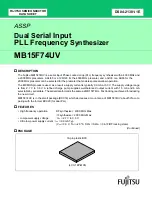
P9700S tips/suggestions
Power cabling and module arrangement.
Each of the 9710, 9720, and 9730 module accessories have power supply connector kits that are four wires,
terminals and a cover, and a four-circuit header. The wires and terminals/cover solder to the module, and the
header, to the one to the left, with the 9700K as the starting module with a header from the 9720FRM kit. The
9720K then plugs into the 9700K, the 9730K plugs into the 9720K and the 9710K plugs into the 9730K. Notice
there is a variation in the direction the header is installed on the 9700K (it faces opposite the way the ones do on
the other three modules. The important thing is to get Plus to plus, and minus to minus, G to G, and SG to SG.
It is OK to put the wires and 4-pin header in either of the two spots on the rear edge of the 9720, 9730, and 9710
modules (the order they appear on the right of the 9700 MIDI2CV8); however, it is best to have the wires at the
edge and the header connector behind them. Using the power connector kit in the 9720, solder the wires to the
edge of the 9720, solder the terminals on the end of the wires, and insert the terminals in the cover. Solder the
4-pin header in the connector kit to the module to which the cable assembly will connect (the 9700 MIDI2CV8 in
this instance. Then, do the same on the 9730, but the header for this goes on the 9720. Then the 9710...
MIDI2CV8 Pitch CV adjustment
The DAC Tune trim can be set by connecting the pitch cv output to a multitester set to measure dc volts in a 0-
10v range and then pressing octave spaced keys on the connected MIDI controller while adjusting the trim for 1v
change.
Later the VCO will be adjusted with this adjusted MIDI2CV8 output. Note too, it is easier to adjust the VCO
pitches when they are in the lower range obtained when the Low-key transpose option is selected as outlined at
the top of the Operating Modes pull-out (power-up the MIDI2CV8 while a the lowest key on the connected MIDI
controller is pressed--then, the first message received is a note-off (when the pressed key is released) which
selects the low-key transpose option).
While a tuner can be useful, it can throw you off if the input is overloaded, clipping the wave and introducing
harmonics.
Here's a way to get them by ear... First set the MIDI2CV8 to be outputting 0V for the low key pressed on the
controller, by powering the 9700K while holding the low key on the controller so that releasing the key will cause
the first message input to the MIDI2CV8 to be a note-off (it interprets this as a signal to output zero volts for this
note number). A dvm can now be used to check that octave spaced key presses are outputting a 1v pitch cv
change (down to a hundredth of a volt or so) as set by the trim on the MIDI2CV8. The most accurate setting will
be obtained if you press octaves that start a few notes above the lowest key, ie if your low key is a C, press D or
higher for the lowest octave reading.
The usual tuned setting for the VCO scale trims is about a 1:00 setting for the pointer of there disk which covers
a cw range from about 7:00 (ccw) to 5:00 (cw). Start with the trim at 1 o'clock.
After having been powered for a minute or two patch the low-key transposed pitch CV over to the VCOA P2
input. Set the two pitch controls to they're both in-tune at unison at about a mid-rotation setting for the low key
pressed on the controller. Play an octave higher and the adjust scaleA for an octave relationship with B. Go
back to the low note and adjust the A panel pitch control for unison and then, again, press an octave higher and
adjust the scaleA for an ocative relationship with B. After going back and forth like this another time or two, you
should find the scale is about as close as it can get. Then, do this all again pressing some note a few keys
higher than the lowest key (with VCOB adjusted to match at this new low pitch) and confirm/tweak the scale to
match for higher pressed octave relationships with B (using the A panel pitch to realign A with B after adjusting
the scale). When the scaleA adjustment is complete, move the pitch control over to VCOB P2 and make the
panel Pitch and scaleB trim adjustments to get unison and octaves with the VCOA pitch (adjusted to match B for
the low key pressed and pitch CV sent to it).






















